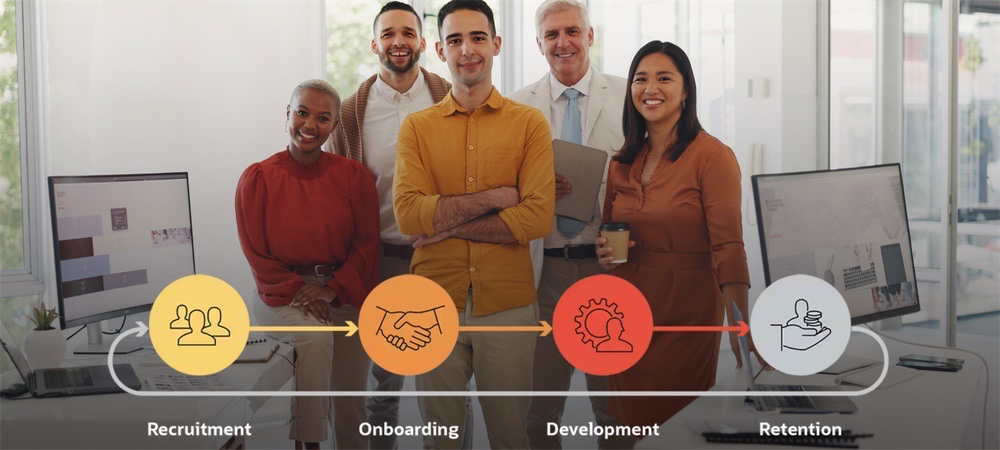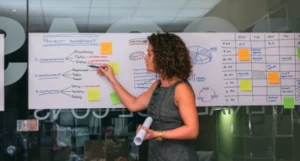The stages of the employee lifecycle: What every employer needs to know and improve the employee lifecycle?

Table of contents
- What is the Employee Lifecycle?
- Stages of the Employee Lifecycle
- Why design an employee lifecycle strategy?
- Strategies for Enhanced Employee Lifecycle Management
- Wrapping up
- Frequently Asked Questions
- 6.1. How does Employee Lifecycle Management differ from HR Management?
- 6.2. Why is an Employee Lifecycle Strategy essential for businesses?
- 6.3. What are the key stages of the Employee Lifecycle?
- 6.4. Can you explain the Employee Lifecycle Model?
- 6.5. How can businesses create an effective Employee Lifecycle Strategy?
Every employee embarks on a journey within your organization, passing through distinct stages from the moment they become aware of your company to the day they depart.
This journey is known as the employee lifecycle, and understanding its stages is crucial for optimizing how you attract, engage, and retain top employees.
In this blog, we’ll delve into the essential stages of the employee lifecycle and explore how cutting-edge software can empower you to improve employee lifecycle management (ELM) at every step.
What is the Employee Lifecycle?
The employee lifecycle encapsulates the journey of an individual or a human resource within an organization, from recruitment to separation. It’s a comprehensive view that includes various touchpoints, experiences, and interactions between the employee and the employer.

Stages of the Employee Lifecycle
Now that you know the basics, let’s take a look at the various stages of the employee lifecycle.
Attraction and Recruitment
Attracting top talent is the starting point of the employee life cycle model. This phase involves sourcing, recruiting, and hiring individuals whose skills align with the company’s vision and culture.
Efficient recruitment strategies, comprehensive job descriptions, and engaging recruitment processes are vital in this stage.
Exceptional onboarding experiences have the potential to boost employee retention almost by 82%.
Onboarding and Integration
A crucial phase of the employee lifecycle is ensuring the smooth assimilation of new hires. Onboarding sets the tone for an employee’s journey, affecting their engagement and retention.
Structured onboarding programs, mentorship, and clear communication channels play a crucial role in integrating new employees seamlessly.
Companies that implemented a well-structured onboarding process observed a 60% increase in year-over-year revenue and a 63% enhancement in year-over-year customer satisfaction levels.
Development and Engagement
Investing in employee growth is imperative. This phase involves training, skill development, and fostering an environment conducive to engagement and productivity.
Ongoing training programs, career development opportunities, and a positive work culture contribute significantly to employee engagement and development.
If a company provided learning and development opportunities, 94% of employees expressed their inclination to extend their tenure with the organization. In fact, One in three employees left their jobs because they didn’t have opportunities to grow in their careers.

Performance Management
Monitoring and evaluating employee performance forms a significant part of the lifecycle. Regular feedback, goal setting, and performance appraisals aid in enhancing productivity.
Clear performance metrics, regular feedback sessions, and transparent evaluation criteria are essential components of effective performance management.
On average, managers dedicate around 210 hours annually to activities related to performance management.
Over 90% of managers express dissatisfaction with the existing annual review process, while nearly 90% of HR leaders mention that the process fails to provide precise information. But, only 6% of Fortune 500 companies have eliminated the practice of ranking their employees.
Retention and Motivation
Keeping top talent engaged and motivated is crucial for organizational success. This phase involves strategies to retain skilled employees and foster a positive work environment.
Recognition programs, opportunities for growth, work-life balance initiatives, and a supportive work culture contribute to employee retention.
Employees demonstrate 3x higher engagement levels when they receive feedback from their managers on a daily basis compared to annual feedback. Additionally, employees who feel motivated are 87% less inclined to leave their jobs voluntarily.
Transition and Separation
The final phase involves the departure of an employee. This stage includes exit interviews, knowledge transfer, and ensuring a smooth transition.
Conducting exit interviews, documenting knowledge, and ensuring a positive exit experience are crucial in this phase. Here are a few reasons why employees leave:
- More than 70% of employees opt to depart for better career prospects.
- Nearly half of the workforce would consider switching jobs for a 20% salary increase.
- Insufficient employee training contributes to 40% of resignations.
Why design an employee lifecycle strategy?
Designing an employee lifecycle strategy is crucial for several reasons.

Comprehensive Approach
Creating an employee lifecycle strategy allows organizations to view the entire journey of an employee, from recruitment to separation, as a cohesive and interconnected process. It ensures that every stage is given due attention, fostering a more holistic approach to workforce management.
Strategic Alignment
Aligning the employee lifecycle strategy with the company’s overall goals, values, and culture ensures that every interaction and touchpoint resonates with the organization’s mission. It allows for consistent messaging and experiences, reinforcing the company’s identity.
Talent Acquisition and Retention
A well-designed strategy aids in attracting top talent by presenting a compelling employer brand during recruitment. It also focuses on retaining skilled employees by offering a positive experience throughout their tenure.
Enhanced Employee Experience
An intentionally designed strategy enhances the overall employee experience. It ensures that employees feel valued, supported, and engaged at every stage, contributing to higher satisfaction and productivity.
Operational Efficiency
A strategic approach streamlines processes, reducing inefficiencies and minimizing the time and resources required for tasks such as onboarding, performance evaluation, and knowledge transfer during transitions.
Data-Driven Decision-Making
By establishing a strategy, organizations can gather and analyze data at each stage of the lifecycle. This data provides insights into trends, areas for improvement, and opportunities to optimize workflows and employee experiences.
Continuous Improvement
An established strategy serves as a framework for ongoing evaluation and improvement. It allows organizations to adapt to changing needs, industry trends, and employee expectations, fostering a culture of continuous enhancement.
Risk Mitigation
Having a well-defined strategy can mitigate risks associated with employee turnover, disengagement, or dissatisfaction. It helps identify potential issues early and implement proactive measures to address them.
Legal and Compliance Considerations
A structured strategy ensures compliance with legal requirements and industry standards at each stage of the employee lifecycle, reducing the risk of legal issues or non-compliance.
Competitive Advantage
Organizations with a well-crafted employee lifecycle strategy often stand out as employers of choice. This attracts top talent, fosters loyalty among employees, and contributes to a positive brand image.
Strategies for Enhanced Employee Lifecycle Management

- Leverage Data-Driven Insights: Analyzing employee data aids in making informed decisions at every stage of the lifecycle.
- Optimize Workflows: Streamlining processes reduces bottlenecks and enhances efficiency in onboarding, task assignments, etc.
- Enhance Productivity: Tracking employee work time and output helps in understanding and optimizing employee productivity.
Wrapping up
While the essence of a robust employee lifecycle strategy lies in its design and implementation, tools like ProHance magnify its efficacy.
They aren’t just enhancers; they’re the gears that refine and elevate each stage of the journey, transforming workforce management into a seamless, data-driven, and performance-enhancing experience.
Achieve operational excellence with ProHance – the catalyst for an optimized employee journey.
Frequently Asked Questions
Q1. How does Employee Lifecycle Management differ from HR Management?
Employee lifecycle management focuses on the entire journey of an employee within the organization, while HR management may encompass broader functions, including recruitment, benefits administration, and compliance. Employee lifecycle management is more comprehensive, addressing specific stages and experiences.
Q2. Why is an Employee Lifecycle Strategy essential for businesses?
An employee lifecycle strategy is vital as it ensures a structured approach to managing employees, optimizing their experiences, and aligning them with the organization’s goals. It allows businesses to attract, develop, and retain talent effectively while fostering a positive work environment.
Q3. What are the key stages of the Employee Lifecycle?
The stages of the employee lifecycle typically include attraction/recruitment, onboarding/integration, development/engagement, performance management, retention/motivation, and transition/separation. Each stage requires specific strategies and attention to ensure a smooth journey for employees.
Q4. Can you explain the Employee Lifecycle Model?
The Employee Lifecycle Model is a visual representation of the various stages an employee goes through within an organization. It showcases the cyclical nature of these stages, emphasizing the continuous nature of recruitment, development, and transition within the workforce.
Q5. How can businesses create an effective Employee Lifecycle Strategy?
Designing an effective Employee Lifecycle Strategy involves understanding the unique needs of employees at each stage, aligning HR processes with organizational goals, leveraging data for informed decision-making, implementing targeted interventions for development, and fostering a culture of continuous improvement.



